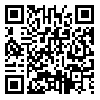1. Alidoust, S, Holden, G & Bosman, CJ 2014, 'Urban environment and social health of the old: a critical discussion on physical, social, and policy environments', Athens Journal of Health, vol. 1, pp. 169-80.
2. Ayoubi Avaz, K, Pravaneh, S, Ali Akbari, A, Miller, W, Reza Soltani, P & Ghahari, S 2015, '[Comparison of social participation level between older adults with assistive mobility devices and those without the devices (Persian)]', Iranian Journal of Ageing, vol. 10, no. 3, pp. 166-73.
3. Bakhtiyari, F, Foroughan, M, Fakhrzadeh, H, Nazari, N, Najafi, B, Alizadeh, M et al 2014, '[Validation of the Persian version of Abbreviated Mental Test (AMT) in old residents of Kahrizak Charity Foundation (Persian)]', Iranian Journal of Diabetes and Metabolism, vol. 13, no. 6, pp. 487-94.
4. Dadkhah, A 2007, '[Review of aged rendered services in USA and Japan and guidelines for Iran Ageing strategic plan (Persian)]', Iranian Journal of Ageing, vol. 2, no. 3, pp. 166-76.
5. Dellamora, MC, Zecevic, AA, Baxter, D, Cramp, A, Fitzsimmons, D & Kloseck, M 2015, 'Review of assessment tools for baseline and follow-up measurement of age-friendliness', Ageing International, vol. 40, no. 2, pp. 149-64. doi: 10.1007/s12126-014-9218-7 [
DOI:10.1007/s12126-014-9218-7]
6. Fitzgerald, KG & Caro, FG 2014, 'An overview of age-friendly cities and communities around the world', Journal of Aging & Social Policy, vol. 26, no. 1-2, pp. 1-18. [
DOI:10.1080/08959420.2014.860786] [
PMID]
7. Ghadir Zadeh, MR, Fadayevatan, R, Akbari Kamrani, AA, Davatgaran, K, Hashemi Nazari, SS, & Mirtorabi, SD 2012, 'Road accident mortality rate of the Iranian Old from 2006 to 2008 (Persian)]', Iranian Journal of Ageing, vol. 7, no. 1, pp. 49-56.
8. Gilmour, H 2012, 'Social participation and the health and well-being of Canadian seniors', Health Reports, vol. 23, no. 4, pp. 23-32. PMID: 23356042 [
PMID]
9. Hodkinson, H 1972, 'Evaluation of a mental test score for assessment of mental impairment in the elderly', Journal of Age and ageing, vol. 1, no. 4, pp. 233-238. doi: 10.1093/ageing/1.4.233 [
DOI:10.1093/ageing/1.4.233]
10. Kadoya, Y 2013, 'Toward an aged-friendly city: the constraints preventing the old 's participation in community programs in Akita city', Working with Old People, vol. 17, pp. 101-108. doi: 10.1108/wwop-05-2013-0012 [
DOI:10.1108/WWOP-05-2013-0012]
11. Kajitani, S 2011, 'Working in old age and health outcomes in Japan', Japan and the World Economy, vol. 23, no. 3, pp. 153-162. doi: 10.1016/j.japwor.2011.06.001 [
DOI:10.1016/j.japwor.2011.06.001]
12. Kharazmi, OA, Zarghani, SH & Johari, L 2014, 'Evaluating of out door spaces and public transportation in Mashhad based on age-friendly cities indicators', Paper Presented at The 6th National Conference on Urban Planning and Management with Emphasis on the Elements of Slamic City, 12 & 13 November 2016, Iran, Mashhad.
13. Lowen, T, Davern, MT, Mavoa, S & Brasher, K 2015, 'Age-friendly cities and communities: access to services for old people', Australian Planner, vol. 52, no. 4, 255-65. doi: 10.1080/07293682.2015.1047874 [
DOI:10.1080/07293682.2015.1047874]
14. Moradi, S, Fekrazad, H, Taher Mousavi, M & Arshi, M 2011, '[The study of relationship between social participation and quality of life of old people who are member of senior association of Tehran city in 2011 (Persian)]', Iranian Journal of Ageing, vol. 7, no. 4, pp. 41-46.
15. Nguyen, OK, Chan, CV, Makam, A, Stieglitz, H & Amarasingham, R 2015, 'Envisioning a social-health information exchange as a platform to support a patient-centered medical neighborhood: a feasibility study', Journal of General Internal Medicine, vol. 30, no. 1, pp. 60-67. doi: 10.1007/s11606-014-2969-8 [
DOI:10.1007/s11606-014-2969-8]
16. Plouffe, L & Kalache, A 2010, 'Towards global age-friendly cities: determining urban features that promote active aging', Journal of Urban Health, vol. 87, no. 5, pp. 733-39. doi: 10.1007/s11524-010-9466-0 [
DOI:10.1007/s11524-010-9466-0]
17. Ribeiro, AI, Mitchell, R, Carvalho, MS & De Pina, MDF 2013, 'Physical activity-friendly neighbourhood among older adults from a medium size urban setting in Southern Europe', Preventive Medicine, vol. 57, no. 5, pp. 664-670. doi: 10.1016/j.ypmed.2013.08.033 [
DOI:10.1016/j.ypmed.2013.08.033]
18. Ruza, J, Kim, JI, Leung, I, Kam, C & Ng, SYM 2015, 'Sustainable, age-friendly cities: An evaluation framework and case study application on Palo Alto, California', Sustainable Cities and Society, vol. 14, pp. 390-96. doi: 10.1016/j.scs.2014.05.013 [
DOI:10.1016/j.scs.2014.05.013]
19. Statistical Center of Iran 2011, National population and housing Census 2011 (1390): Selected Findings, Statistical Center of Iran, Tehran, Viewed 18 October 2015, http://www.amar.org.ir
20. Steels, S 2015, 'Key characteristics of age-friendly cities and communities: A review', Cities, vol. 47, pp. 45-52. doi: 10.1016/j.cities.2015.02.004 [
DOI:10.1016/j.cities.2015.02.004]
21. Takagi, D, Kondo, K & Kawachi, I 2013, 'Social participation and mental health: moderating effects of gender, social role and rurality', BMC Public Health, vol. 13, no. 1, pp. 1. doi: 10.1186/1471-2458-13-701 [
DOI:10.1186/1471-2458-13-701]
22. Tehran Municipality 2015, Age-Friendly City, viewed 29 October 2015, http://www.region2.tehran.ir.default.aspx?tabid=274&ArticleId=47704
23. Telatar, G, Üner, S, Özcebe, H, Bicer, B, & Sari, Ö 2015, 'Defining the satisfaction from healthcare services among old in Sinop, Turkey, 2014', The European Journal of Public Health, vol. 25, no. 3. doi: 10.1093/eurpub/ckv175.039 [
DOI:10.1093/eurpub/ckv175.039]
24. The United Department of Economic and Social affairs 2015, World Populations prospects, UN, New York.
25. The United Department of Economic and Social affairs 2013, World population ageing, UN, New York.
26. WHO 2009a, The World Health Organisation: Global Age-Friendly Cities, Guide and Checklist, A review of their use by local government, World Health Organization, Geneva, viewed 15 August 2015, http://www.mav.asn.au/policy-services/social-community/ageing-disability/ageing/Documents
27. WHO 2009b, WHO global network of age-friendly cities, World Health Organization, Geneva, Viewed 10 September 2015, http://www.who.int.entity.ageing.projects.age-friendly-cities-network.en
28. WHO 2011a, Global age-friendly cities: a guide 2007, World Health Organization, Geneva, Viewed 22 August 2015, http://www.who.int.ageing.publications
29. WHO 2013a, WHO global network of age-friendly cities and communities, World Health Organization, Geneva, Viewed 22 August 2015, http://www.who.int.ageing.projects.age_friendly_cities_network.en
30. WHO 2015a, Definition of an older or old person, World Health Organization, Geneva, Viewed 20 September 2015, http://www.who.int.healthinfo.survey.ageingdefnolder.en






